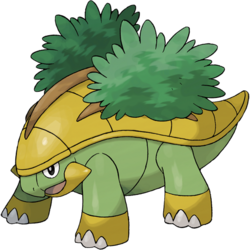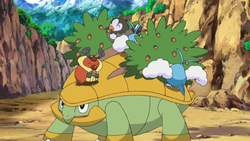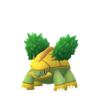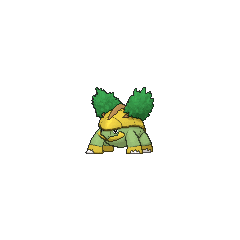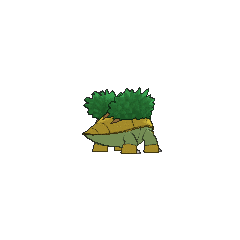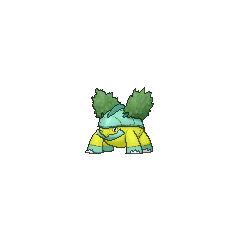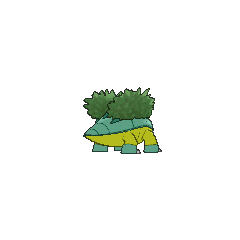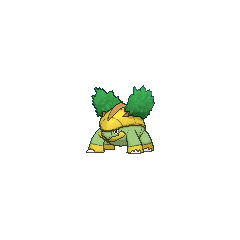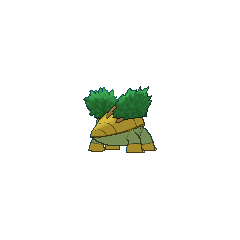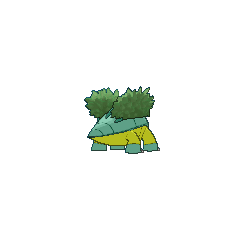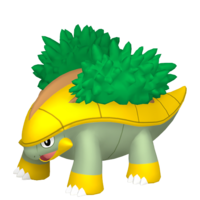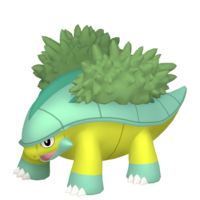From Bulbapedia, the community-driven Pokémon encyclopedia.
Grotle (Japanese: ハヤシガメ Hayashigame) is a Grass-type Pokémon introduced in Generation IV.
It evolves from Turtwig starting at level 18 and evolves into Torterra starting at level 32.
Biology
Grotle is a quadrupedal Pokémon with light green skin and a large shell covering its back. The shell is composed of hardened soil and conforms to the shape of Grotle's body, extending from its forehead to the tip of its short tail. The shell appears sectioned and is yellow with three long, brown ridges atop it. There are two bush-like trees growing around the outermost ridges. Grotle's lower jaw is yellow and has triangular extensions on the cheeks, while its upper jaw has a hooked tip. Its feet are yellow and have three claws each.
Grotle has the ability to sense where pure water wells up, and will carry other Pokémon on its back to these sources. It lives in forests but leaves during the day to allow more sunlight on its trees. Grotle has also been observed living near clean spring water. Berries grow on the trees, attracting some species of Pokémon. The berries it grows are said to be sweet and very delicious. In the anime, Grotle is seen to produce acorn-like nuts instead.
Evolution
Grotle evolves from Turtwig and evolves into Torterra
(For specifics on this Pokémon's evolution in the games, refer to Game data→Evolution data.)
In the anime
Major appearances
Ash's Turtwig evolved into a Grotle in Aiding the Enemy!, which also marked the species' debut. In The Fleeing Tower of Sunyshore!, Grotle evolved into a Torterra.
Minor appearances
A Grotle appeared in the opening sequence of Zoroark: Master of Illusions.
A Grotle appeared in Eyes on the Goal!, under the ownership of the Shell Sage.
Pokédex entries
In the manga
Pocket Monsters Diamond & Pearl
- Main article: Ash's Grotle
Ash's Grotle first appeared in PDP29, where it evolved from a Turtwig.
Pokémon Adventures
- Main article: Tru
In Ring Around the Roserade I, Diamond's Turtwig, Tru, evolved into a Grotle. He became stronger and (slightly) faster in this new form, but was scarcely used for battles, as he would have been ineffective against Gardenia's Grass-type Pokémon, though he still helped Platinum train for future Gym battles. Soon afterwards, Grotle became a Torterra alongside Chimler in Veilstone City fighting a legion of Team Galactic Grunts, and his power and endurance grew tremendously.
Pokémon Diamond and Pearl Adventure!
Jun's Turtwig evolved into a Grotle off-screen and later into Torterra.
In the TCG
- Main article: Grotle (TCG)
Game data
Pokédex entries
| This Pokémon was unavailable prior to Generation IV.
|
| Generation IV
|
|
Sinnoh
#002
|
|
Johto
#—
|
| Diamond
|
It lives along water in forests. In the daytime, it leaves the forest to sunbathe its treed shell.
|
| Pearl
|
The shell is hardened soil. Some Pokémon come to peck the berries growing on the trees on its back.
|
| Platinum
|
It knows where pure water wells up. It carries fellow Pokémon there on its back.
|
| HeartGold
|
A Grotle that lives in the forest is said to have its own secret springwater.
|
| SoulSilver
|
|
|
| Generation V
|
|
|
Unova
#—
|
| Black
|
It knows where pure water wells up. It carries fellow Pokémon there on its back.
|
| White
|
| Black 2
|
It knows where pure water wells up. It carries fellow Pokémon there on its back.
|
| White 2
|
|
|
| Generation VI
|
|
Kalos
#—
|
|
Hoenn
#—
|
| X
|
It lives along water in forests. In the daytime, it leaves the forest to sunbathe its treed shell.
|
| Y
|
It knows where pure water wells up. It carries fellow Pokémon there on its back.
|
| Omega Ruby
|
It lives along water in forests. In the daytime, it leaves the forest to sunbathe its treed shell.
|
| Alpha Sapphire
|
It knows where pure water wells up. It carries fellow Pokémon there on its back.
|
|
|
|
|
| Generation VIII
|
|
Galar
#—
|
|
Sinnoh
#002
|
|
Hisui
#131
|
| This Pokémon has no Pokédex entries in Sword and Shield.
|
| Brilliant Diamond
|
It lives along water in forests. In the daytime, it leaves the forest to sunbathe the trees on its shell.
|
| Shining Pearl
|
Its shell is hardened soil. Some Pokémon come to peck the berries growing on the trees on its back.
|
| Legends: Arceus
|
Appears where there is clean spring water. The fruit that grows on the shrubs on its shell is sweet, nutritious, and truly delicious.
|
|
|
|
|
Game locations
| This Pokémon was unavailable prior to Generation IV.
|
|
|
|
|
|
|
|
|
|
|
|
|
In side games
| This Pokémon was unavailable prior to Generation IV.
|
|
|
|
|
|
|
|
|
| Generation VIII
|
|
| This Pokémon is unavailable in Generation VIII side games.
|
|
|
|
|
Stats
Base stats
| Stat
|
Range
|
| At Lv. 50
|
At Lv. 100
|
75
|
|
135 - 182
|
260 - 354
|
89
|
|
84 - 155
|
164 - 304
|
85
|
|
81 - 150
|
157 - 295
|
55
|
|
54 - 117
|
103 - 229
|
65
|
|
63 - 128
|
121 - 251
|
36
|
|
36 - 96
|
69 - 188
|
Total: 405
|
Other Pokémon with this total
|
- Minimum stats are calculated with 0 EVs, IVs of 0, and (if applicable) a hindering nature.
- Maximum stats are calculated with 252 EVs, IVs of 31, and (if applicable) a helpful nature.
|
Pokéathlon stats
Type effectiveness
| Under normal battle conditions in Generation IX, this Pokémon is:
|
|
|
|
|
|
|
|
|
|
|
|
|
Learnset
|
|
|
|
- Bold indicates a move that gets STAB when used by Grotle
- Italic indicates a move that gets STAB only when used by an Evolution of Grotle
- Click on the generation numbers at the top to see level-up moves from other generations
|
|
|
|
|
- Bold indicates a move that gets STAB when used by Grotle
- Italic indicates a move that gets STAB only when used by an Evolution or an alternate form of Grotle
- Click on the generation numbers at the top to see TM moves from other generations
|
|
|
|
|
- Moves marked with an asterisk (*) must be chain bred onto Grotle
- Bold indicates a move that gets STAB when used by Grotle
- Italic indicates a move that gets STAB only when used by an Evolution of Grotle
- Click on the generation numbers at the top to see Egg moves from other generations
|
|
|
|
|
- Bold indicates a move that gets STAB when used by Grotle
- Italic indicates a move that gets STAB only when used by an Evolution of Grotle
- Click on the generation numbers at the top to see moves from other generations
|
Side game data
|
|
|
|
Pokémon Ranger: Guardian Signs
| Group:
|
|
Poké Assist:
(present)
|

|
Field move:
(present)
|

(Tackle ×3)
|
Poké Assist:
(past)
|

|
Field move:
(past)
|

(Tackle ×1)
|
| Browser entry R-140/N-040
|
| It creates vines around itself that make Pokémon Slowed.
|
|
|
|
|
|
Pokémon Rumble Rush

|
Walking Speed: 1.25 seconds
|
Base HP: 54
|
|
| Base Attack: 75
|
Base Defense: 54
|
Base Speed: 60
|
|
|
|
|
|
|
|
Evolution data
Sprites
| This Pokémon was unavailable prior to Generation IV.
|
|
|
|
|
|
|
|
|
|
|
| This Pokémon is unavailable in Generation IX.
|
|
|
Other sprites

|
| Platinum intro's sprite
|
Trivia
- Grotle is the heaviest of the second-stage starter Pokémon, at 213.8 lbs. (97.0 kg), being heavier than many other fully evolved starter Pokémon.
- Grotle is the only second-stage Sinnoh starter Pokémon to evolve at level 32. Monferno and Prinplup both evolve at level 36.
- When Grotle evolves into Torterra, all of its stats increase by 20 points.
Origin
Bulbanews has an article related to this subject:
Grotle seems to be based on a snapping turtle, but it may also originate from a World Turtle, most likely Akūpāra. It also shares characteristics with armored Ankylosaurs.
Name origin
Grotle may be a combination of grove, grow, and turtle.
Hayashigame may be a combination of 林 hayashi (grove) and 亀 kame (turtle).
In other languages
| Language
|
Title
|
Meaning
|
 Japanese Japanese
|
ハヤシガメ Hayashigame
|
From 林 hayashi and 亀 kame
|
 French French
|
Boskara
|
From bosquet and carapace
|
 Spanish Spanish
|
Grotle
|
Same as English name
|
 German German
|
Chelcarain
|
From the genus Chelonia, Carapax, and Hain
|
 Italian Italian
|
Grotle
|
Same as English name
|
 Korean Korean
|
수풀부기 Supulbugi
|
From 수풀 supul and 거북이 geobugi
|
 Mandarin Chinese Mandarin Chinese
|
樹林龜 / 树林龟 Shùlínguī
|
From 樹林 / 树林 shùlín and 龜 / 龟 guī
|
 Cantonese Chinese Cantonese Chinese
|
樹林龜 Syuhlàhmgwāi
|
From 樹林 syuhlàhm and 龜 gwāi
|
|
|
|
| More languages
|
 Hindi Hindi
|
ग्रोटल Grotle
|
Transcription of English name
|
 Thai Thai
|
ฮายาชิกาเมะ Hayachikame
|
Transcription of Japanese name
|
|
|
|
Related articles
External links

|
This Pokémon article is part of Project Pokédex, a Bulbapedia project that aims to write comprehensive articles on each Pokémon species, as well as Pokémon groups and forms.
|


 For other sprites and images, please see Grotle images on the Bulbagarden Archives.
For other sprites and images, please see Grotle images on the Bulbagarden Archives.

